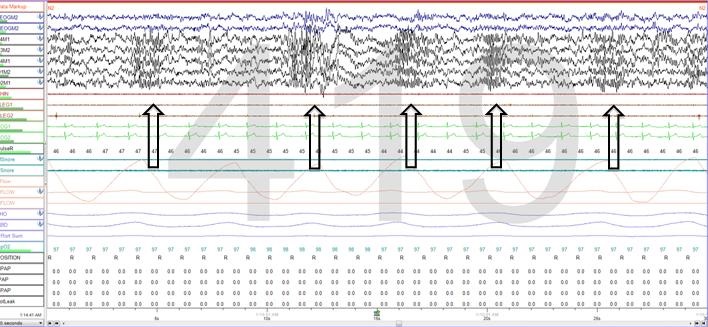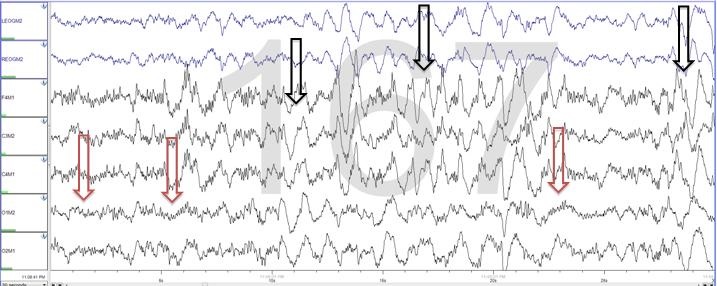Alpha Intrusion on Overnight Polysomnogram
 Thursday, June 5, 2014 at 8:00AM
Thursday, June 5, 2014 at 8:00AM Ryan Nahapetian, MD, MPHa and John Roehrs, MDb
aPulmonary, Allergy, Critical Care, & Sleep Medicine, University of Arizona, Tucson, AZ
bSouthern Arizona Veterans Administration Health Care System, Tucson, AZ

Figure 1. Thirty second polysomnogram epoch showing stage N2 non-REM sleep with frequent bursts of alpha frequency waves (black arrows).

Figure 2. Thirty second polysomnogram epoch showing stage N3 delta sleep (black arrows) with overriding alpha frequency (red arrows)
A 30 year-old Army veteran with a past medical history significant for chronic lumbar back pain stemming from a fall-from-height injury sustained in 2006 was referred to the sleep laboratory for evaluation of chronic fatigue and excessive daytime hypersomnolence. His Epworth sleepiness scale score was 16. He denied a history of snoring and witnessed apnea. Body Mass Index (BMI) was 25.7 kg/m2. His main sleep related complaints were frequent nocturnal arousals, poor sleep quality, un-refreshing sleep, prolonged latency to sleep onset, and nightmares. An In-lab attended diagnostic polysomnogram was performed. Sleep efficiency was reduced (73%) and overall arousal index was not significantly elevated (3.2 events/hour). The sleep study showed rapid eye movement (REM) related sleep disordered breathing that did not meet diagnostic criteria for sleep apnea. There was no evidence for period limb movement disorder. However, the study was significant for alpha wave intrusion in stage N2 non-REM and stage N3 delta sleep. Example epochs are shown in figures 1 and 2.
Alpha wave activity is characteristic of drowsy wakefulness and represents the background electro-encephalographic (EEG) pattern of the occipital region of the brain. Alpha activity occurs when individuals close their eyes and the occipital region loses visual stimulus. Alpha-Delta sleep is defined by a mixture of 5-20% delta waves combined with alpha-like rhythms that are interspersed among the delta waves and was first described in 1973 by Hauri & Hawkins (1). Alpha-Delta sleep has been associated with various neuro-psychiatric conditions including schizophrenia, depression, schizoaffective disorder, narcotic addiction, temporal epilepsy, fibromyalgia, chronic fatigue syndrome, and chronic pain syndrome (1,2). Alpha wave intrusion has also been shown to occur in stage N2 non-REM sleep in individuals with fibromyalgia and chronic pain. Poor sleep quality is often reported in individuals with complaints of chronic pain. It is suggested that alpha wave intrusion correlates with pain severity and can be used as a monitor to assess response to therapy (3).
References
-
Hauri P, Hawkins D. Alpha-delta sleep. Electroencephalogr and Clin Neurophysiol. 1973; 34(3): 233-7. [CrossRef] [PubMed]
-
Manu P, Lane TJ, Matthews DA, Castriotta RJ, Watson RK, Abeles M. Alpha-delta sleep in patients with a chief complaint of chronic fatigue. South Med J. 1994; 87(4): 465-70. [CrossRef] [PubMed]
-
Roizenblatt S, Molodofsky H, Benedito-Silva AA, Tufik S. Alpha sleep characteristics in fibromyalgia. Arthritis Rheum. 2001; 44(1): 222-30. [CrossRef] [PubMed]
Reference as: Nahapetian R, Roehrs JD. Alpha intrusion on ovenight polysomnogram. Southwest J Pulm Crit Care. 2014;8(6):334-5. doi: http://dx.doi.org/10.13175/swjpcc075-14 PDF

Reader Comments